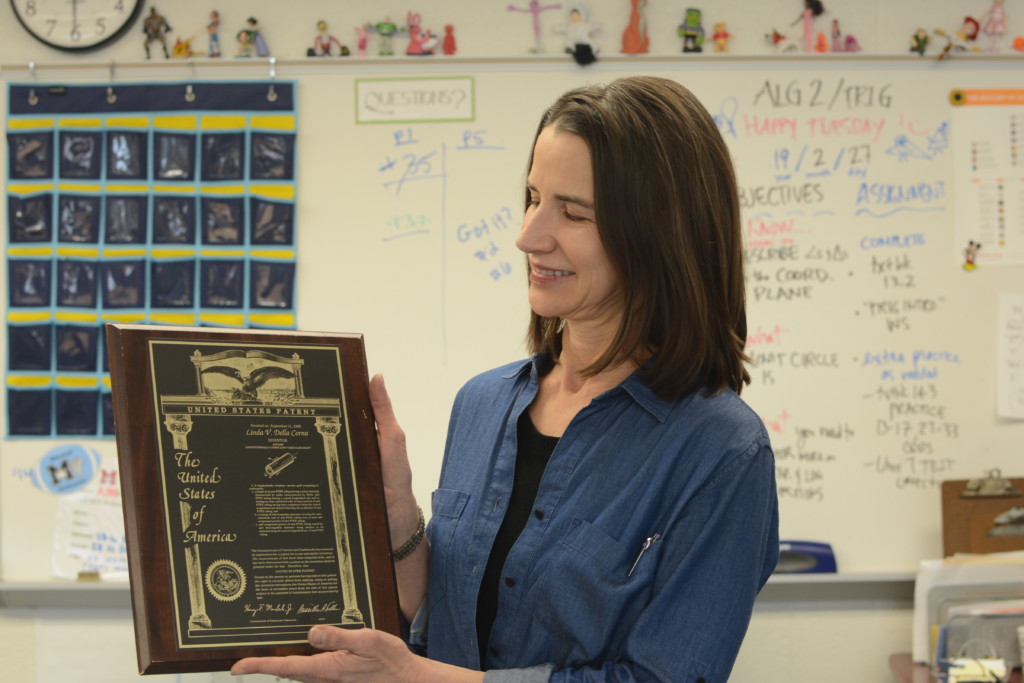Math teacher Linda Della Corna is holding what looks like a cut-out portion of a tiny garden hose. The off-white tube has two thin blue stripes running down the side with the texture of a baseball. This tubular object in Della Corna’s hand is a prosthetic artery, specifically the non-porous coated Polytetrafluorethylene (PTFE) graft. It serves as a new vein in transplants that have saved upwards of 1,000 lives in a variety of ways. Della Corna would know what it is. After all, she invented it.
Della Corna joined Impra, an Arizona-based cardiovascular engineering company, immediately after graduating from college. Her husband was pursuing a graduate degree at the University of Arizona, and Della Corna needed a job to support the couple until her husband graduated. After a few telephone interviews, Della Corna had become one of only seven bioengineers working on prosthetic blood vessels. Her new boss assigned her to two tasks: improving the prosthetic blood vessels and improving the manufacturing process to make them. Though Della Corna said she liked doing both jobs, she found product design to be more intriguing.
“I liked [working on the product and the production line], but probably if I had to choose, [I preferred] the devices themselves, making improvements, making new versions of them and making totally new things, which is what results in the patent,” Della Corna said.
In October 1989, the United States Patent and Trademark Office (USPTO) named Della Corna on her first patent for the Longitudinally Compliant Vascular Graft (LCVG). The concept of the LCVG had existed before Della Corna even worked at Impra, but her patent model improved the previously existing product. This practice of improvement is commonplace in the profession of engineering, and Della Corna said her work largely relied on work other scientists had previously done.
“Anything that’s new, you usually have to rely on people that came before you or people you’re working with to come up with some new, improved thing,” Della Corna said. “This was true of all the things that I was named as an author on for the patents.”
Della Corna worked with Impra bioengineers Robert C. Farnan, William M. Colone and Rajagopal R. Kowligi, who comprised the first team of scientists Della Corna collaborated with to author a patent. Over the next two years she would author three more patents with other scientists, but Farnan, Colone and Kowligi always remained a part of her team.
“All of [the patents], when I look back, were joint efforts,” Della Corna said. “It wasn’t just me, it was this group that I was working with.”
In 1992 alone, the (USPTO) granted Della Corna patents for two models of the blood vessel patch and the PTFE graft. Every year, Della Corna shows the PTFE graft to her classes. She doesn’t tell them what it is at first, and lets the students make their own inferences. Della Corna said part of the beauty of teaching is handing off knowledge to young people so they may someday carry on the tradition of learning.
“The reason I became a math teacher is because I saw how important it is to learn a lot,” Della Corna said. “It is really such a privilege and honor to be a part of passing on the wisdom from so many previous generations that I acquired, and that I was able to use and benefit from.”
In 1996, pharmaceutical company C.R. Bard acquired Impra in a 143.2 million dollar buyout. Della Corna had left years before, after her husband received his Degree in Science at the University of Arizona. The other members of her team followed suit, but not to become teachers. Kowligi now works at Thoratec Incorporated, a pharmaceutical company similar to Impra. Farnan went on to work with a company called CircuLite Incorporated before working independently to receive his latest patent in 2018. Colone continued work on the PTFE graft and patented the Radically Expandable PTFE graft in 2012. But Della Corna’s inventions, even after more than 20 years, are still impacting lives today. Due to its uses in transplants, dialysis and surgery, some 1,000 people owe their lives to Della Corna and her team of college graduates.
2019-03-25

